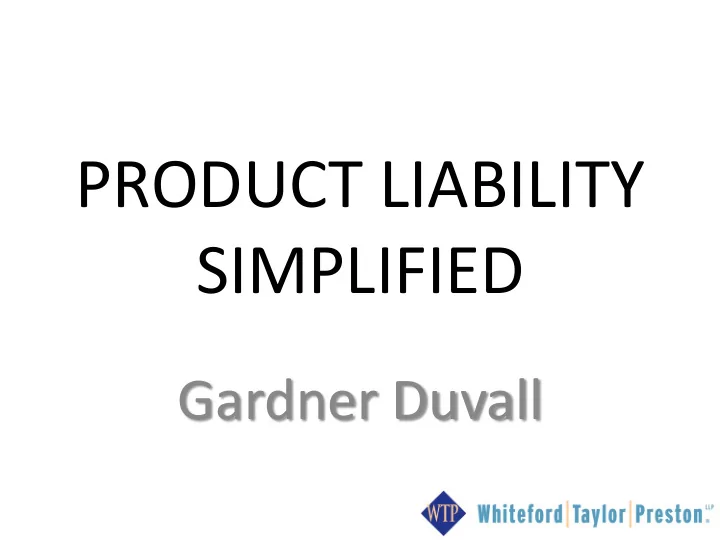

PRODUCT LIABILITY SIMPLIFIED Gardner Duvall
How does the independent lab fit into product safety and product liability?
The Pinto and the Coffee Cup
Two types of suits for money Contract Tort o Mutual promises o Relationship of parties creates a non- o Breach of promise contractual duty of care o Resulting loss o Breach of duty of care o Money damages o Resulting loss o Money damages
Product Liability is a Tort • Product liability is imposed when a product is not reasonably safe for its intended use and for foreseeable misuse. • A seller of products is liable to consumers for products which are not reasonably safe, and which therefore cause bodily injury.
2 questions for independent labs? • Has anyone ever approached you to test something and tell them that the thing was “reasonably safe,” without regard to benchmarks or parameters? • Do you do business with “consumers”?
The Ford Pinto
Cute car with a problem • Early model years of the Pinto had a nasty habit of going up in flames when rear-ended. • Is it unreasonably unsafe to have a car that explodes when crashed, since the intended purpose of the car is to drive, not crash? • Accidents are foreseeable use or misuse for cars, so cars have to be designed to reasonably survive a crash.
Which is safer? Which is reasonably safe? Turbo 911 M1 Abrams
Pinto: real car, real problem Fire hazard alone would be enough to create product liability, but there was more o Car rushed into production with known risk of explosion in low-speed rear end collisions o Company tested 4 effective fixes, all with prices less than $12 per car o Company calculated that liability payments were less expensive than making the running change
Pinto recap • Car which burns as a result of low- speed collision is not reasonably safe • Additionally, what lawyers call “bad facts” make for a liability disaster
Hot coffee to go
One renowned lawsuit Facts in Liebeck v. McDonald’s lawsuit o Coffee served at drive-up window at 180° F o Caused third-degree burns in a matter of seconds o Liebeck wanted to settle for $10,000 in medical bills for skin grafts o Many prior complaints about coffee temperature
Is it reasonably safe? • It is as reasonably foreseeable that beverages will spill on skin as that cars will get run into • 180° coffee will cause third-degree or other severe burns • Is there some functional reason to serve coffee that hot? • McDonald’s offered some commercial reasons, but coffee cannot be drunk at 180°
Personal responsibility • Each state has a rule about how the plaintiff’s fault affects recovery • Most states reduce the recovery in proportion to the plaintiff’s fault • A few states deny recovery if the plaintiff has any fault at all • No knowledge about how this affected McDonald’s liability
3 phases of product liability • Design – is the design reasonably safe? A car that explodes in low-impact collision Coffee too hot to drink and hot enough to cause third-degree burns • Manufacture – is the product made to spec? • Warning – Is there information about safe use?
Ineffective warning
Design and warning • Warning does not take care of poor design: CAUTION CONTENTS HOT • Design creates a reasonably safe product, warning then provides information on safe use
Points for the independent lab • Products liability is a type of tort, which applies special considerations to the general standard of due care and reasonable safety • General considerations of due care and reasonable safety govern non-contractual liability whether or not products are involved • Clients of an independent lab may use your testing to design products or for quality control
Points for the independent lab • Your clients may need benchmarked performance data, but “reasonable safety” is usually not a matter of benchmarking • Labs should not have product liability because you have no relationship with the product user, and you are not designing or making products
Risk for independent labs • Contractual liability to the client if testing is deficient, and that results in product liability for the client. • Contractual terms may control liability in this instance.
Recommend
More recommend